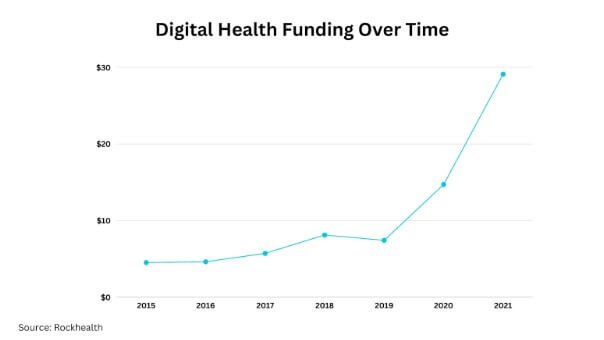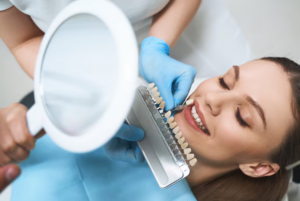
How to Enhance Healthcare Communication with Omnichannel Solutions
The healthcare landscape is rapidly evolving. With the rise of digital health interventions (DHIs), we now have an opportunity to provide personalized, engaging, and integrated care to patients like never before. However, realizing the full potential of DHIs requires omnichannel strategies that enhance communication across the entire patient journey.
Source: Rockhealth
The Advent of Digital Health Interventions
DHIs cover all kinds of digital and mobile health tech, from wearables and telehealth to patient portals and gadgets that keep an eye on you from afar. There are now over 350,000 DHIs worldwide.
The COVID-19 pandemic has been a catalyst for the adoption of DHIs on a global scale. Telehealth use has increased 38x from pre-pandemic levels in the US alone. Patient engagement with DHIs is now an indispensable part of healthcare.
The potential benefits of DHIs include:
- Increased access to care and reduced costs
- Improved health outcomes through better self-management
- Enhanced patient experience and satisfaction
- Higher efficiency and productivity for providers
But for DHIs to deliver on their promise, call center integration for Oracle Service Cloud requires a laser focus on patient engagement. This is where omnichannel communication strategies come into the picture.
Why Omnichannel Engagement is Crucial for DHIs
Omnichannel engagement refers to orchestrating a seamless experience for patients across multiple digital and non-digital communication channels. The goal is to provide flexible, synchronized, and personalized interactions that keep patients engaged with DHIs long-term.
Enhanced patient engagement through omnichannel strategies can improve adherence to DHI interventions by nearly 70%.
Some key advantages of omnichannel engagement in healthcare include:
- Tailored care: Patients get to connect with Digital Health Interventions (DHIs) in the way they like best, whenever it suits them.
- Reduced drop-offs: Follow-ups across channels prevent patients from abandoning interventions.
- Improved satisfaction: A seamless experience keeps patients happy and motivated.
- Enhanced outcomes: Sustained engagement leads to better health results.
However, effective implementation of omnichannel strategies does come with its share of challenges:
- Outdated IT systems make data integration and channel coordination difficult.
- Organizational inertia inhibits change management.
- Privacy concerns around personalization must be addressed.
- Resource constraints impact the speed of rollout.
But the benefits far outweigh these temporary growing pains. With new investments in digital infrastructure and a patient-centric culture, healthcare systems can overcome adoption barriers.
Choosing the Right Communication Channels
The very first thing to do when creating a killer omnichannel plan is to figure out which communication channels are the perfect fit. This requires an understanding of the patient journey and touchpoints best suited for each stage.
The patient journey can be broadly classified into four stages:
- Awareness: Learning about the DHI and its benefits.
- Onboarding: Signing up for the DHI.
- Engagement: Actively using the DHI as intended.
- Sustainability: Maintaining engagement long-term.
Different channels like email, SMS, push notifications, and chatbots serve distinct purposes at each stage. Orchestrating these channels to provide unified, consistent messaging guarantees seamless omnichannel engagement.
Things like emails and SMS messages are great for getting the word out and raising awareness. On the other hand, chatbots and self-service portals make it a breeze for folks to hop on board and get started. Push notifications and telehealth consultations can then nurture active engagement. Finally, periodic emailed surveys and check-ins via calls/texts can ensure sustained participation.
However, channel selection must be personalized based on individual preferences. Younger demographics may prefer text-based touchpoints while older cohorts are more responsive to phone calls. Proactively seeking patient input can ensure channel effectiveness.
Omnichannel Strategies to Drive Behavioral Change
Omnichannel engagement, when implemented effectively, has immense potential to positively influence health behaviors and outcomes. The retail industry has successfully employed these strategies to boost customer engagement and sales. Healthcare can take a similar data-driven, customer-centric approach with patients.
Let’s examine a sample patient journey to demonstrate how omnichannel communication can drive long-term behavioral change:
Stage 1: Awareness
- A patient learns about a DHI for diabetes management through an email campaign and clicks a link to access more details online.
Stage 2: Onboarding
- After researching online, the patient signs up on the DHI portal. Later, receive an automated SMS welcoming them to the program.
Stage 3: Engagement
- Over the next few weeks, the patient actively logs health metrics through the DHI app, supported by periodic push notifications. And, also has a telehealth call with a coach for motivation.
Stage 4: Sustainability
- The patient is sent occasional emails checking on their progress. Their app usage data triggers more SMS outreach to improve adherence. The patient is satisfied with the level of personalization.
In this example, the synchronized use of automated and personalized messaging across channels ensures the patient remains engaged with the DHI. This ultimately helps drive positive health behavior change.
To make this patient journey even more powerful, let’s take a look at some extra omnichannel tricks that could really do the trick:
- Surveys: Seek periodic feedback from the patient on their experience and channel preferences.
- Reminders: Use SMS/email to remind the patient about upcoming telehealth consultations.
- Peer Groups: Connect the patient with other patients like them for motivation.
- Gamification: Incentivize consistent app usage through points/rewards.
- Remote Monitoring: Sync the patient’s health devices with their medical records.
- Care Team Alerts: Notify the patient’s providers about any concerning trends.
As evident, omnichannel communication enables a continuous cycle of listening, learning, and improving – key elements that drive sustained patient engagement and behavioral change.
The Future is Omnichannel
As digital transformation accelerates, healthcare communication must evolve from being fragmented to orchestrated. While DHIs have laid the foundation, realizing their full potential requires omnichannel strategies centered around the patient.
By taking an integrated, data-driven approach, we can deliver healthcare that is:
- Seamless: Consistent experiences across channels.
- Personalized: Tailored to individual preferences.
- Proactive: Preventive outreach before drop-offs.
- Continuous: Regular feedback and improvements.
The future belongs to healthcare providers who embrace DHIs and omnichannel engagement to offer their patients unified, personalized journeys. Communication will glue binding care teams, interventions, and patients together—leading to satisfied individuals and thriving communities.
Frequently Asked Questions
What are some challenges in implementing omnichannel strategies for DHIs?
Potential challenges include siloed and outdated technology systems, lack of data integration, privacy concerns around personalization, and the need for organizational change management. But the benefits outweigh the growing pains of adopting new approaches.
How can healthcare systems measure the effectiveness of omnichannel engagement for DHIs?
Key metrics to track include patient satisfaction, intervention uptake and adherence, outcomes linked to behavior change, and cost savings from improved efficiencies. Surveys and real-time analytics provide actionable insights.
Which communication channels should healthcare prioritize for omnichannel strategies?
While needs may vary, essential channels are mobile messaging, telehealth, patient portals, email, and remote monitoring devices. The goal is to allow seamless transitions between digital and human interactions.
What is the role of care teams in driving omnichannel success?
Care teams must embrace new responsibilities in guiding patients through digitally-enabled journeys. Their human touch remains vital, especially when motivating patients to progress through different DHI engagement stages.
How can healthcare organizations shift their culture to support omnichannel strategies?
Change management is key. Leadership must communicate a compelling vision and urgency around patient-centric digital transformation. Cross-functional collaboration and training will enable new ways of orchestrated working.







